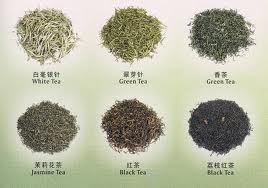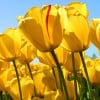Chai also known as Tea in English - an explanation of different kinds of tea
The first cup of tea! Tea is the world's most popular prepared drink. It was discovered by Chinese Emperor Shen Nung in 2737 B.C., when a tea leaf accidentally fell into the bowl of hot water he was drinking.
In 1650, Peter Stuyvesant brought tea to the American colonists in New Amsterdam, later called New York. Soon the colonists were drinking more tea than all England. The first tea shipment to arrive in Canada was imported by the Hudson Bay Company in 1716 and took more than a year to arrive.
In the early 19th century, afternoon tea as a social custom, was originated by Anna, 7th Duchess of Bedford. The Duchess began inviting guests to join her for a cup of tea and some sweets and savouries in the afternoon, in order to fill the long gap between breakfast and late dinners. The ritual caught on in England and North America and soon became an afternoon tradition that remains today. Modern afternoon tea at trendy tea salons and cafés feature a wide variety of quality teas and fine finger foods.
Today tea is grown on tea estates and 70% of the tea we drink is grown in Sri Lanka, India, Indonesia, Kenya, Argentina and China. The best climates for growing tea are those that are tropical or semi-tropical and tea can be grown on soil that is not fit for growing much of anything else. Today there are three basic types of tea: black, oolong and green and from these three types spring over 3,000 cultivated varieties. The leaves are picked at just the right moment designated by the tea estate manager, then crushed to start the oxidation process.
How to make East African tea
Ingredients for 8 servings:
- 6 cups water
- 7 teaspoons tea leaves
- 6 cups milk
10 -15 teaspoons sugar
Heat together water and tea leaves in a 3 to 4 quart saucepan. Boil 10 minutes. Add milk and heat to near boiling. Strain leaves. Add sugar to taste.
How to make Chinese Tea
You can use the tea bags and simply pour two or three tea spoons of the leaves inside the tea bag, twist the bag and place it in the cup. Alternatively if you do not use the tea bags, simply add the leaves to the cup and let them settle in the bottom, this is “The Chinese way”

Tea Varieties
The most important tea-producing nations, in alphabetical order, are: Argentina, China, India, Indonesia, Iran, Japan, Kenya, Sri Lanka (Ceylon), Turkey and Viet Nam.
Warm climates with lush soil and mountainous regions are great for growing tea.
There are four main types of tea which are, white, green, oolong, and black, all which are born from the same species of plant.
Common health facts about tea show us that it is rich in antioxidants, can shield our immune systems, top infection, and even help us shed some pounds!
Indian Teas
One of the classic Indian teas, this is grown in the Brahmaputra Valley in northeast India. The taste is strong and malty. The best quality Assam teas contain the "tips," or unopened buds, from the bushes and are known as Tippy Assam .
Darjeeling
Another popular tea from Northern India, this type is noted for its distinctive, delicate flavor. The small, broken-leaf grade produces a light, golden drink with a subtle flavor. Bushes from the highest tea gardens in the foothills of the Himalayas have large leaves that produce teas with a unique "muscatel" flavor of perfumed grapes. The most notable of all the various Darjeelings is Darjeeling Broken Orange Pekoe , which is sometimes called the champagne of tea.
Ceylon Teas
Dimbula
Grown at altitudes reaching 11/4 miles (2 km) and over, this tea has a fine quality and, like most Ceylon tea, a rich color and flavor.
Kandy
This tea is noted for its full-bodied quality and strength, appealing particularly to those who like a robust beverage.
Nuwara Elz:ya
A light, "bright" tea with a fragrant flavor, this is excellent when served with lemon wedges.
Uva
This is a fine-flavored tea from the eastern slopes of the central mountains.
Chinese Black Teas
Keemum
A delicate and aromatic tea from Northern China, this is low in tannins with a deep, rich flavor.
Lapsang Souchong
A large-leaf tea that is rich and full-bodied, this has a very distinctive but delicate smoky, tarry flavor.
Yunnan Western
A tea containing a high proportion of the youngest leaves, this has a sweet taste and a light golden color.
Chinese tea - tea leaves
Chinese tea is categorized based on its way of manufacture.
6 types of tea: Green, yellow, black, white, light green and red.
Green tea has the longest history and it can be dated over 3000 years ago. People picked the young shoots of leaves and dried it in the sun without fermentation.
Examples of green tea:
- Long Jing
- Fur Tip
- Green Spring Snail
Yellow tea is to ferment the tea leaves before they are totally dry. A degree of 10% to 20% fermentation would be expected.
Examples of yellow tea:
- Silver Needle
- Yellow Soup
- Big Leaf Green
Black tea is to ferment tea leaves to a degree of 100%. It is a kind of commonly consumed tea in Mongolia.
Examples of black tea:
- Pu'er
- Cake tea
- Brick tea
Produced for the most part in China, white teas are made from the buds and young leaves, where other teas are made from more mature leaves. The buds and leaves may be shielded from the sun, so no chlorophyll may be formed in them. Flavor is sweet and light. Tea leaves are usually young ones covered with white fur.
Examples of white tea:
- Longevity Eyebrow
- White Peony
- Silver Needle White Fur
Green tea
Light green tea is a kind of tea lightly fermented to a degree of 30% - 60%. Tea leaves are green in the middle and red on the fringe. This type of tea gives a taste of fruit or flowers.
Examples of Light green tea:
- Water Fairy
- SONG Species Long Bush
- Iron Guan Yin
Red tea
Red tea is a kind of tea fermented to a degree of 80% - 90%. Western countries usually call it Black Tea. It usually gives a taste of roses.
Examples of red tea:
Healing aspects of Chinese tea
Chinese tea is known to have good healing power. It not only boosts health but also allows longevity. However, we should avoid tea which has been left cool for a long time or overnight.
Take Oolong as an example, it can reduce the fat in blood. It has been known for a long time that tea can reduce the fat in human body. Or take Pu'er or white tea as an example, it would be ideal for people to maintain a slim body. Apart from the effects above, all the three teas can reduce the possibility of developing cancer.
- Dandelion Chai Tea, Ginger Root Juice, and a Remedy ...
Harvest and roast your own dandelion roots, juice your ginger and dry the pulp, and try this cold and flu prevention supplement. - Health Benefits of Drinking White Tea: Look and Feel...
Research shows that white tea has special properties that will make you look and feel young, beautiful and full of energy. This article goes into the myriad ways it helps you feel fantastic, and how it works to help you look youthful. - Starbuck's Tazo Teas, more than just tea
When the word Starbucks is pronounced what usually hits our minds is a nice, steamy cup of coffee. Starbucks after all, has become the icon of coffee, the king of all coffee shops, the place to hang out with... - The Truth about Wu Yi Tea
Japanese Green Teas
Sencha
These long, green leaves make a light, bright easy-to-drink tea that is good for everyday drinking.
Sencha Brancha
This is a combination of tea leaves and rice that results in a drink with a nutty flavor.
Taiwan (Formosa) Oolong Tea
Considered by some experts to be one of the finest of teas, this has a natural fruity flavor that is not too strong.
Formosa Oolong Peach Blossom
This tea does not contain peach blossom-it takes its name from its unique peachy flavor that is found only in the best-quality teas.
Blended Teas
Most packages of commercial tea are made up of a blend of fifteen or more leaves from different areas. There are also some rather special traditional teas that are blended. English Breakfast Tea is a blend of strong Indian teas that gives a full-bodied and fragrant drink. Earl Grey Tea is a blend of Keemun and Darjeeling teas flavored with oil of bee balm. The recipe was given to the diplomat Earl Grey by a Chinese mandarin, and the earl took the recipe back with him to England. Russian Caravan Tea is a blend of fine teas from China, Taiwan, and India. It was originally transported to Russia from India via camel caravan; hence its name.
Herbal Teas
While most other teas contain caffeine and act as stimulants, herbal teas generally do not contain any (unless blended with other teas), though some will still simulative while others act as sedatives. Herbal Teas are often drunk for their effects or medicinal properties. Most herbal teas are best on their own, without the addition of milk, lemon or sugar
Jasmine Tea
Traditionally served with dim sum dishes, this is a classic Chinese tea. It is a green tea, exotically scented with the addition of real jasmine flowers.
Rose Pouchong Tea
From the province of Guangdong, this is made by interspersing flower petals with the tea leaves during drying. It makes a pale, soothing tea. Rose Congou is another rose-scented tea.
Chrysanthemum Tea
This is medium strength black China tea blended with chrysanthemum flowers.
Orchid Tea
This is obtained by blending a semi fermented oolong tea with crushed orchid flowers. It makes a light, delicate, and fragrant brew, considered to be the tea of connoisseurs.
Lychee Tea
This is a traditional Chinese blend that is perfumed with the husks of the Lychee fruit.
Fruit Teas
Modern blends are produced using varied fruits: apricots, black currants, apples, wild cherries, passion fruit, oranges, lemons, and mangoes. The producers of fruit teas carefully blend their own mixtures of China, Indian, and Ceylon teas to go with the chosen fruit.
Teas from Roots
Ginger root tea, South Pacific Kava root tea and licorice teas are examples.
Teas from Grains
Roasted barley tea, known as bori cha in Korea and mugicha in Japan, has a coffee-like taste and is usually served cold. Roasted wheat tea also tastes like coffee. Roasted corn and toasted rice teas are also served in Korea.
Tea from other Herbs:
Vatnip and chamomile tea used to calm, echinacea used to alleviate and help prevent cold and flu symptoms, Essiac tea used to treat cancer, fennel, hibiscus used for longevity, honey bush, gentian, horehound, labrador, lapacho made from the inner bark of the Lapacho tree, lemongrass, coca tea made from coca leaves, mint teas, European mistletoe, nettle leaf, raspberry leaf, rooibos tea AKA red tea touted for its antioxidants, rose hip, sage, sassafras, skullcap, thyme, tulsi, vetiver, wong logat, woodruff, yarrow, yerba mate, and yuen kut lam kam wo tea.
Rooibos, colloquially known as Red Tea, is a herbal plant grown in South Africa. Rooibos is a flavourful, caffeine-free alternative to tea.









